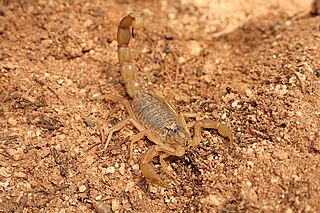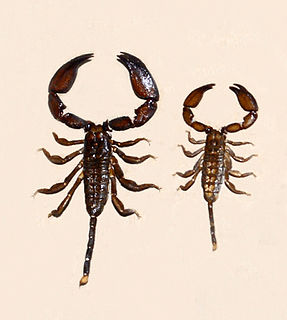
The Buthidae are the largest family of scorpions, containing about 80 genera and over 800 species as of mid-2008. Its members are known as, for example, fat-tailed scorpions and bark scorpions. A few very large genera are known, but a high number of species-poor or monotypic ones also exist. New taxa are being described at a rate of several to several dozen new species per year. They occur in the warmer parts of every major landmass on Earth, except on New Zealand. Together with four other families the Buthidae make up the superfamily Buthoidea. The family was established by Carl Ludwig Koch in 1837.

The Journal of the Bombay Natural History Society is a natural history journal published several times a year by the Bombay Natural History Society. First published in January 1886, and published with only a few interruptions since, the JBNHS is one of the best-known journals in the fields of natural history, conservation, and biodiversity research.
Iberiotoxin (IbTX) is an ion channel toxin purified from the Eastern Indian red scorpion Buthus tamulus. Iberiotoxin selectively inhibits the current through large-conductance calcium-activated potassium channels.

Buthus occitanus, the common yellow scorpion, is a species of scorpion in the family Buthidae. It occurs in the Middle East, North Africa and Europe.
BmTx3 is a neurotoxin, which is a component of the venom of the scorpion Buthus Martensi Karsch. It blocks A-type potassium channels in the central nervous system and hERG-channels in the heart.

Heterometrus, whose members are also known by the collective vernacular name giant forest scorpions, is a genus of scorpions belonging to the family Scorpionidae. It is distributed widely across tropical and subtropical southeastern Asia, including Cambodia, Laos, Thailand, Vietnam, India, Sri Lanka, Nepal, and China (Tibet). It is notable for containing some of the largest living species of scorpions.
BmKAEP is a neurotoxin from the venom of the Manchurian scorpion (Mesobuthus martensii). It is a β-toxin, which shift the activation voltage of sodium channels towards more negative potentials.

Mesobuthus martensii is a species of scorpion in the family Buthidae. Its common names include Chinese scorpion, Manchurian scorpion, Chinese armor-tail scorpion and Chinese golden scorpion. Despite its common name, this scorpion is not only found in Manchuria or China, but also in Mongolia and Japan. Its preferred habitat is warm, dry areas with little vegetation. M. martensii can grow to about 6 centimetres (2.4 in) long, with females usually slightly larger, and has a life-span of about 4 to 6 years.
In molecular biology, the BmKK2 toxins are a family of scorpion toxins. They belong to the scorpion toxin subfamily alpha-KTx 14. They include a novel short-chain peptide from the Asian scorpion Mesobuthus martensii Karsch, a potassium channel blocker composed of 31 amino acid residues. The peptide adopts a classical alpha/beta-scaffold for alpha-KTxs. BmKK2 selectively inhibits the delayed rectifier K+ current, but does not affect the fast transient K+ current.

Mesobuthus eupeus is a polymorphic scorpion species belonging to the well-known family Buthidae. Commonly known as the lesser Asian scorpion or the mottled scorpion. It is thought to be the most widely dispersed species of the genus Mesobuthus, perhaps even of the family Buthidae.
BeKm-1 is a toxin from the Central Asian scorpion Buthus eupeus. BeKm-1 acts by selectively inhibiting the human Ether-à-go-go Related Gene (hERG) channels, which are voltage gated potassium ion channels.
Bukatoxin is an α-scorpion toxin found in the venom of the Chinese scorpion Buthus martensi Karsch. By blocking the inactivation of sodium ion channels, α-scorpion toxins prolong action potentials.

Buthus is a genus of scorpion belonging and being eponymous to the family Buthidae. It is distributed widely across northern Africa, including Morocco, Mauritania, Algeria, Tunisia, Libya, Egypt, Senegal, Guinea-Bissau, Nigeria, Sudan, Somalia, Ethiopia, Djibouti, as well as the Middle East, including Israel, Palestine, Jordan, Lebanon, Iraq, Yemen, and possibly Saudi Arabia and southern Turkey. Its European range includes the Iberian Peninsula, southern France, and Cyprus.
BotIT2 is a neurotoxin from the scorpion Buthus occitanus tunetanus, which modifies activation and slows down the deactivation of voltage gated sodium channels.
Tamulotoxin is a venomous neurotoxin from the Indian Red Scorpion.

Liocheles australasiae, the Dwarf Wood Scorpion, is a species of scorpions belonging to the family Hemiscorpiidae.

Buthus ibericus is a scorpion species found in western Spain and Portugal.
Buthus kunti is a scorpion species found in Cyprus.
BmP02, also known as α-KTx 9.1 or Bmkk(6), is a toxin from the Buthus Martensi Karsch (BmK) scorpion. The toxin acts on potassium channels, blocking Kv1.3 and slowing the deactivation of Kv4.2. BmP02 is not toxic to humans or mice.
Wilson R. Lourenço is a French-Brazilian arachnologist specializing in scorpions.







